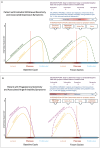A call to integrate menstrual cycle influences into just-in-time adaptive interventions for suicide prevention
- PMID: 39703456
- PMCID: PMC11655188
- DOI: 10.3389/fpsyt.2024.1434499
A call to integrate menstrual cycle influences into just-in-time adaptive interventions for suicide prevention
Abstract
This paper discusses the scientific rationale and methodological considerations for incorporating the menstrual cycle as a time-varying intra-individual factor in personalized medicine models, such as Just-In-Time Adaptive Interventions (JITAIs). Among patients, accumulating evidence suggests that the normal hormone fluctuations of the menstrual cycle represent a time-varying factor that can trigger or exacerbate psychiatric symptoms, including but not limited to affective dysregulation, suicidality, and irritability. While only a minority of the general female population experiences significant cyclical changes, this hormone-sensitive response appears to be greater among patients with psychiatric disorders, with studies demonstrating that a majority of patients recruited for past-month suicidal ideation demonstrate worsening of their suicidality around menses. However, no interventions target suicidality during this monthly period of elevated risk despite evidence of a clear recurring biological trigger. This unique and recurrent "biotype" of suicidality is well-suited for JITAIs. In addition to providing a rationale for the inclusion of the cycle in JITAI, we provide illustrative options and examples regarding the measurement and implementation of cycle variables in JITAIs. We discuss how JITAIs might be leveraged to use menstrual cycle data to identify states of vulnerability within people and strategically select and deploy interventions based upon their receptivity at various phases in the cycle. Furthermore, we discuss how to integrate passive measures for tracking the menstrual cycle. Although much research is needed before implementation, we maintain that the menstrual cycle represents a critically understudied time-varying feature that may markedly improve the accuracy of JITAI models for predicting suicidality.
Keywords: digital phenotyping; idiographic modeling; just-in-time adaptative intervention; menstrual cycle; mobile health; passive measures; self-injury; suicide.
Copyright © 2024 Tauseef, Coppersmith, Reid-Russell, Nagpal, Ross, Nock and Eisenlohr-Moul.
Conflict of interest statement
MN receives publication royalties from Macmillan, Pearson, and UpToDate. He has been a paid consultant in the past three years for Apple, Microsoft, COMPASS Pathways, and Cambridge Health Alliance, and for legal cases regarding a death by suicide. He has stock options in Cerebral Inc. He is an unpaid scientific advisor for Empatica, Koko, and TalkLife. The remaining authors declare that the research was conducted in the absence of any commercial or financial relationships that could be construed as a potential conflict of interest.
Figures

Similar articles
-
Predicting Acute Changes in Suicidal Ideation and Planning: A Longitudinal Study of Symptom Mediators and the Role of the Menstrual Cycle in Female Psychiatric Outpatients With Suicidality.Am J Psychiatry. 2024 Jan 1;181(1):57-67. doi: 10.1176/appi.ajp.20230303. Epub 2023 Dec 14. Am J Psychiatry. 2024. PMID: 38093647 Free PMC article.
-
Precision medicine for suicidality: from universality to subtypes and personalization.Mol Psychiatry. 2017 Sep;22(9):1250-1273. doi: 10.1038/mp.2017.128. Epub 2017 Aug 15. Mol Psychiatry. 2017. PMID: 28809398 Free PMC article.
-
The influence of minority stress on indicators of suicidality among lesbian, gay, bisexual and transgender adults in Thailand.J Psychiatr Ment Health Nurs. 2021 Aug;28(4):656-669. doi: 10.1111/jpm.12713. Epub 2020 Dec 1. J Psychiatr Ment Health Nurs. 2021. PMID: 33190351
-
Personalized interventions for behaviour change: A scoping review of just-in-time adaptive interventions.Br J Health Psychol. 2025 Feb;30(1):e12766. doi: 10.1111/bjhp.12766. Epub 2024 Nov 14. Br J Health Psychol. 2025. PMID: 39542743 Free PMC article.
-
Just-in-Time Adaptive Mechanisms of Popular Mobile Apps for Individuals With Depression: Systematic App Search and Literature Review.J Med Internet Res. 2021 Sep 28;23(9):e29412. doi: 10.2196/29412. J Med Internet Res. 2021. PMID: 34309569 Free PMC article.
References
-
- Eisenlohr-Moul TA, Bowers SM, Prinstein MJ, Schmalenberger KM, Walsh EC, Young SL, et al. . Effects of acute estradiol and progesterone on perimenstrual exacerbation of suicidal ideation and related symptoms: a crossover randomized controlled trial. Translational psychiatry (2022). 12(1), 528. doi: 10.1038/s41398-022-02294-1 - DOI - PMC - PubMed
Grants and funding
LinkOut - more resources
Full Text Sources
Miscellaneous

